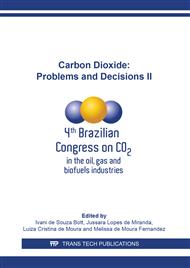p.59
p.69
p.79
p.87
p.97
p.107
p.117
p.125
p.133
Offshore Natural Gas Conditioning and Recovery of Methanol as Hydrate Inhibitor with Supersonic Separators: Increasing Energy Efficiency with Lower CO2 Emissions
Abstract:
The oil and gas industry represents an important contributor to CO2 emissions as offshore platforms are power intensive for producing, processing and transporting hydrocarbons. In offshore rigs CO2 emissions mainly come from on-site gas-fired power generation for heat and electricity production. The accumulation of atmospheric CO2 is one of the main causes of the planetary greenhouse effect, thus CO2 emissions should be minimized. To achieve that, more energy efficient processes for natural gas (NG) conditioning are needed in order to minimize platform power consumption and thus lowering the associated generation of CO2. In addition, in offshore scenarios gas-hydrate obstructions are a major concern in flow assurance strategies, since thermodynamic conditions favoring hydrate formation are present, such as high pressure, low external temperature and gas contact with free water. To avoid hydrate issues, hydrate inhibition is carried out by the injection of a thermodynamic hydrate inhibitor (THI) in well-heads such that it flows along with production fluids, thus removing the thermodynamic conditions for hydrate formation and ensuring unimpeded flow. Therefore, the three-phase high-pressure separator (HPS) is fed with production fluids, where the HPS splits the feed into: (i) an upper gas phase, (ii) hydrocarbon condensate, and (iii) a bottom aqueous phase. The gas phase goes to NG conditioning for hydrocarbon dew point adjustment (HCDPA) and water dew point adjustment (WDPA) so as to make NG exportable. The hydrocarbon condensate (if present) is collected for stabilization and the bottom aqueous phase consisting of water, salts and THI is sent to a THI recovery unit (THI-RU) for THI re-concentration and reinjection. In conventional plants, WDPA and HCDPA are done by glycol absorption and Joule-Thomson expansion respectively. Moreover, the HPS gas carries some THI such as methanol that is lost in the processing. This work analyses a new process – SS-THI-Recovery – where HPS gas feeds a supersonic separator (SS) with injected water and compares it to the conventional processing. As a result, SS ejects a cold two-phase condensate with almost all water, THI and C3+ hydrocarbons, discharging exportable NG with enough HCDPA and WDPA grades, while the condensate gives aqueous THI returned to the THI-RU and LPG with high commercial value. Thus, SS-THI-Recovery not only avoids THI losses as well as exports NG and LPG. Both conventional gas plant and SS-THI-Recovery alternative coupled to THI-RU were simulated in HYSYS 8.8 for a given NG field and targeting the same product specifications. SS-THI-Recovery presented lower power consumption and thus less associated CO2 emissions, while potentially increasing the gas plant profitability, as THI losses are significantly reduced and higher flow rate of LPG with higher commercial value is produced in comparison with the conventional alternative. Hence, the higher efficiency of SS-THI-recovery makes it not only more environmentally friendly with lower CO2 emissions, but also a potential alternative for improving process economics and thus providing an economic leverage that could justify investments in carbon capture technologies, contributing to avoid CO2 emissions even more with cleaner NG and LPG production.
Info:
Periodical:
Pages:
97-105
Citation:
Online since:
July 2019
Price:
Сopyright:
© 2019 Trans Tech Publications Ltd. All Rights Reserved
Share:
Citation:


